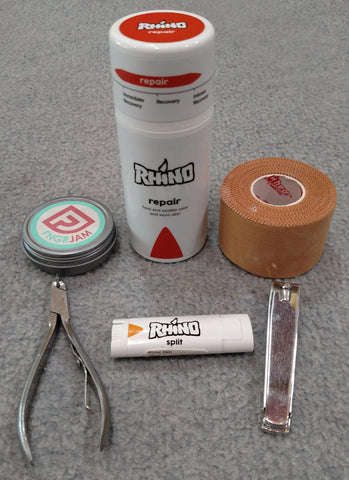
Skin Care for Climbers
The Basics
In climbing, everything comes down to your hands. This means that the condition of your skin is of utmost importance. Anyone who has been climbing for a while, or has climbed in the Milks here in Bishop, has reached a point where skin was a limiting factor. In order to minimize the abuse your skin takes and thereby optimize your climbing, you should consider always keeping a Hand Kit with you, whether in or outdoors. At minimum, it should include:
Tape
Tape is useful in two ways: for help with skin issues and/or to support your tendons/pulleys. It is always a good idea to have some on hand.
Finger Nail Clippers
I think this is self-explanatory.
Cuticle Clippers
These are useful for trimming down torn bits of skin. The idea to cut the skin flap close to the finger pad to avoid it catching and tearing even more. Used with the next item on the list, this can be very effective in minimizing tears and splits.
Sandpaper
Sandpaper can be used to file down torn or lifted skin so that your finger pad is a single, smooth surface. This minimizes the chances of tears getting worse. You can also use sandpaper to sand down the excess, dead skin that often builds up around old splits or in the creases of the first pad joint. Dead, hard skin tends to split, while fresh, more supple skin is more resilient!
Balm/Lotion
Whether you stick with a hard balm, go for an all-out lotion, or use both depends on your skin. If you tend towards dry skin, I recommend both for the same reasons mentioned above: dry skin splits! If you tend to have moist skin, then a hard balm is probably best.
The Deep Dive
The above list covers the absolute basics without going into too much detail. If you are ready for what will probably be WAY too much information on each, keep reading. Otherwise, turn back now!
Tape
As mentioned above, tape can be used to help cover splits to extend a climbing day/trip or it can be used to support your tendons and pulleys. For covering splits, a few tips are useful:
Use thin strips and make sure the overlap well and so that the exposed edges point towards the end of your fingers. This will keep the edges from lifting and allow the tape to stay in place longer. Also, be sure to start well above the split and cover well below it.
If you know that a climb has some particularly sharp holds, consider pre-taping, especially if you are working out the beta. This will save your skin, and you can always take the tape off for send burns.
While a quick internet search will give you all the information you need about the various ways to tape pulleys and tendons, here are a few tips:
Be aware that tape will not heal a sore tendon or pulley; at most, it will support and mask the issue. You can still injure a finger further even with tape!
As above, consider pre-taping if you are working a line with tweaky holds and/or pockets.
Thicker widths, around half the width of an average roll, work well for supporting fingers.
Finger Nail and Cuticle Clippers
I will deal with these together, as they serve similar purposes and can be interchangeable in a pinch.
The first thing to note is that your fingernails can be too long - a pulled back nail can end a session quick! - and they can be too short - this hurts! Everyone is different, so it is up to you to find a middle ground.
Cuticle clippers are excellent for trimming back runs of skin that are likely to, if left unattended, be pulled back far and deep. That said, you have to be careful not to cut too deeply. Stay superficial!
Sandpaper
As said above, torn up skin likes to tear more. Proper use of sandpaper can take ruined tips and give them a nice, even surface that will be less likely to tear more. Be wary though! It is possible to over-sand and thin your tips to the point where they bust through more easily. Also, many companies offer various tools, but I have found simple sanding blocks, like the kind woodworkers use, to be the best. They are cheap, last a long time, and come in a variety of grits.
Balm and Lotion
The skin game doesn’t just happen at the crag. It is just as important to keep up on your skin care at home. A few tips:
Dry flesh does not heal! Clip and sand away dead skin and use balm liberally, especially if you are prone to dry hands.
For deep and persistent splits, I fill the wound with whatever balm I prefer, cover it with a band-aid, and leave it on overnight. This will leave it soft and fleshy, and so it may need to be covered if I am climbing again, but I find that it decreases the amount of time it takes for the split to heal.
Hydrate! Often, skin prone to splitting is skin that is dehydrated. Make sure to drink enough water, and remember this when you crack that after session beer!
Everyone’s skin is different, so pay attention and experiment. The goal is to find the middle ground between skin so dry it splits and so soft it tears.
Finally, the climbing world is full of various companies that make excellent products geared towards skin care. At Sage to Summit, we carry some of the best; come in and take a look at what we have!

